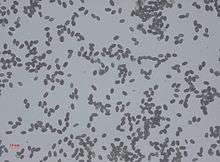Stachybotrys
| Stachybotrys | |
|---|---|
| Scientific classification | |
| Kingdom: | Fungi |
| Phylum: | Ascomycota |
| Class: | Sordariomycetes |
| Order: | Hypocreales |
| Family: | Stachybotryaceae |
| Genus: | Stachybotrys Corda, 1837 |
| Species | |
|
~ 50, see text | |
Stachybotrys (Stak-ē-bot′ris) is a genus of molds, hyphomycetes or asexually reproducing, filamentous fungi. Historically, it was considered closely related to the genus Memnoniella,[1][2] because the spores are produced in slimy heads rather than in dry chains. Recently, the synonymy of the two genera is generally accepted.[3] Most Stachybotrys species inhabit materials rich in cellulose. The genus has a widespread distribution, and contains about 50 species.[4] The name comes from the Greek words "stakhus" (ear of grain, stalk, stick; σταχυς) or "stachy" (progeny) and "botrus" (cluster or bunch as in grapes, trusses; βότρυς).
The most infamous species, S. chartarum (previously known as S. atra) and S. chlorohalonata, are known as "black mold" or "toxic black mold" in the U.S., and are frequently associated with poor indoor air quality that arises after fungal growth on water-damaged building materials.[5] According to the Center for Disease Control and Prevention, "The term 'toxic mold' is not accurate. While certain molds are toxigenic, meaning they can produce toxins (specifically mycotoxins), the molds themselves are not toxic, or poisonous. Hazards presented by molds that may produce mycotoxins should be considered the same as other common molds which can grow in your house."[6]
Removal
The CDC recommends using soap and water or bleach to remove the mold.[7]
Pathogenicity

Symptoms of Stachybotrys exposure in humans
A controversy began in the early 1990s after analysis of two infant deaths and multiple cases in children from the poor areas of Cleveland, Ohio, due to pulmonary hemorrhage were initially linked to exposure to heavy amounts of Stachybotrys chartarum. Subsequent and extensive reanalysis of the cases by the United States Centers for Disease Control and Prevention have failed to find any link between the deaths and the mold exposure.[8]
Species
- Stachybotrys albipes (Berk. & Broome) S.C. Jong & Davis (1976)
- Stachybotrys alternans Bonord. (1851)
- Stachybotrys breviuscula McKenzie (1991)
- Stachybotrys chartarum (Ehrenb.) S. Hughes (1958)
- Stachybotrys chlorohalonata B. Andersen & Thrane (2003)
- Stachybotrys cylindrospora C.N. Jensen (1912)
- Stachybotrys dichroa Grove (1886)
- Stachybotrys elegans (Pidopl.) W. Gams (1980)
- Stachybotrys eucylindrospora D.W. Li (2007)
- Stachybotrys freycinetiae McKenzie (1991)
- Stachybotrys kampalensis Hansf. (1943)
- Stachybotrys kapiti Whitton, McKenzie & K.D. Hyde (2001)
- Stachybotrys longispora Matsush. (1975)
- Stachybotrys mangiferae P.C. Misra & S.K. Srivast. (1982)
- Stachybotrys microspora (B.L. Mathur & Sankhla) S.C. Jong & E.E. Davis (1976)
- Stachybotrys nephrodes McKenzie (1991)
- Stachybotrys nephrospora Hansf. (1943)
- Stachybotrys nilagirica Subram. (1957)
- Stachybotrys oenanthes M.B. Ellis (1971)
- Stachybotrys parvispora S. Hughes (1952)
- Stachybotrys ruwenzoriensis Matsush. (1985)
- Stachybotrys sansevieriae G.P. Agarwal & N.D. Sharma (1974)
- Stachybotrys sinuatophora Matsush. (1971)
- Stachybotrys suthepensis Photita, P. Lumyong, K.D. Hyde & McKenzie (2003)
- Stachybotrys theobromae Hansf. (1943)
- Stachybotrys waitakere Whitton, McKenzie & K.D. Hyde (2001)
See also
References
- ↑ Haugland RA, Vesper SJ, Harmon SM (2001). "Phylogenetic relationships of Memnoniella and Stachybotrys species and evaluation of morphological features for Memnoniella species identification". Mycologia. Mycologia, Vol. 93, No. 1. 93 (1): 54–65. doi:10.2307/3761605. JSTOR 3761605.
- ↑ Castlebury L, Rossman A, Sung G, Hyten A, Spatafora J (2004). "Multigene phylogeny reveals new lineage for Stachybotrys chartarum, the indoor air fungus". Mycol Res. 108 (Pt 8): 864–72. doi:10.1017/S0953756204000607. PMID 15449591.
- ↑ Seifert, K.A.; Kendrick, B.; Morgan-Jones, G.; Gams, W. (2011). The Genera of Hyphomycetes. CBS Fungal Biodiversity Centre, the Netherlands. pp. 1–997.
- ↑ Kirk PM, Cannon PF, Minter DW, Stalpers JA (2008). Dictionary of the Fungi (10th ed.). Wallingford: CABI. p. 659. ISBN 978-0-85199-826-8.
- ↑ Fog Nielsen K (2003). "Mycotoxin production by indoor molds". Fungal Genet Biol. 39 (2): 103–17. doi:10.1016/S1087-1845(03)00026-4. PMID 12781669.
- ↑ "Facts about Stachybotrys chartarum and Other Molds". Centers for Disease Control and Prevention. U.S. Department of Health & Human Services. September 18, 2012. Retrieved 2015-12-16.
- ↑ "Facts about Stachybotrys chartarum and Other Molds - How do you get the molds out of buildings, including homes, schools, and places of employment?". Centers for Disease Control and Prevention. U.S. Department of Health & Human Services. September 18, 2012. Retrieved 2015-12-16.
- ↑ Centers for Disease Control and Prevention (CDC) (2001). "Availability of case definition for acute idiopathic pulmonary hemorrhage in infants". MMWR. 50: 494–495.
Further reading
- Black Mold: Your Health and Your Home (2003) ISBN 0-9743943-9-4
External links
- www.cdc.gov/mold/stachy.htm "Facts about Stachybotrys chartarum and Other Molds", United States Center for Disease Control and Prevention